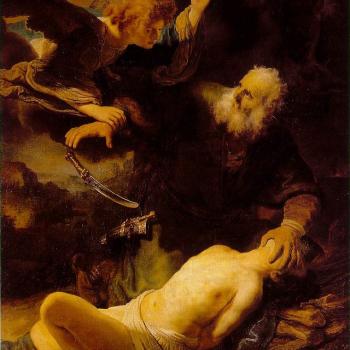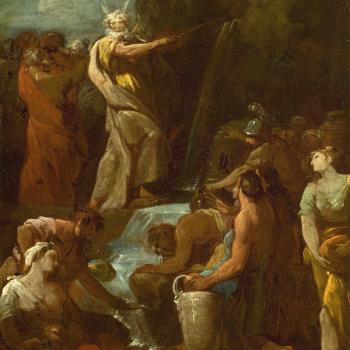Atheist anti-theist Jonathan M. S. Pearce is the main writer on the blog, A Tippling Philosopher. His “About” page states: “Pearce is a philosopher, author, blogger, public speaker and teacher from Hampshire in the UK. He specialises in philosophy of religion, but likes to turn his hand to science, psychology, politics and anything involved in investigating reality.”
This is a reply to his post, Matthew & John’s Threes: Fact or Literary Device? (11-30-21). His words will be in blue; Michael Alter’s in green.
*****
The Gospels are littered with literary devices and mechanisms that serve narrative purposes but leave the reader doubting the veracity of the claims. . . . Numerology is certainly important, whether it be the number 12, the gematria of groups of 14 and 7 in the genealogies, the Pythagorean 153 fish caught, and 3. 3 is a big one that Matthew and John love.
Michael J. Alter, in his magisterial work The Resurrection: A Critical Inquiry, documents Matthew and John’s usage of the number three in the various groupings that they contain: [many examples given]
Yes, I’m very familiar with Mr. Alter. I have critiqued this book of his 29 times.
Just another example of why we should doubt the claims made in the Gospels, since they seem to be fulfilling other functions and agendas than truth-telling.
First of all, three important considerations must be stressed:
1) Use of literary / rhetorical techniques is not intrinsically opposed to the reporting of facts; the two things are not mutually exclusive.
2) Use of such techniques, including numerology and the stress on the number three in particular, is by no means confined to the Bible. They were used very widely use in the ancient world, especially among the “rational” Greeks, renowned for their reason and logic.
3) Several individual items on the list that Mr. Alter draws up are at least arguably often arbitrary and/or of no particular or great significance.
Numerology is unquestionably a prominent phenomenon in the Bible, which has been examined in great depth and endorsed by Bible believers (see an example devoted to “three” in the Bible). What we object to in the above presentation is the insulting and illogical accusation that use of these techniques somehow cast into doubt the veracity of biblical claims. They do not inherently do that at all (and I would contend that this is self-evident), per #1 above. Yet Pearce blithely assumes that this is fundamentally or essentially contrary to “truth-telling” and he ludicrously pits facts and numerology against each other in a false dichotomy (“Fact or Literary Device”).
I shall tackle the issue described in #3 above, first (the following all being examples from Alter’s book):
Mt 1:1-17—The names of Abraham’s descendants were manipulated into three sets of fourteen individual male descendants.
I think it was simply making a sensible division of the three lists into 1) patriarchal period, 2) Israel’s monarchy, and 3) post-exilic period in Babylon. If there is any numerology here, it would seem to be regarding “14” and not “3.”
Mt 1:20-24—Three “people” were identified prior to Mary’s conception: (1) Joseph, (2) Mary, (3) and the angel.
It’s actually five, because Jesus is also mentioned (1:21), as is [Isaiah] “the prophet” (1:22). Moreover, why stop at 1:24? By what criterion do we know where these alleged or actual triads occur?; within which limits? The original New Testament had no chapters of verse divisions. The chapters we use now were introduced in the early 13th century, and the present verse numbers were used no earlier than 1551. So Matthew 2:1 mentions four more people: Herod and the magi.
Mt 4:4, 6 and 7—The statement “for it was written” was repeated three times.
The devil challenged Jesus three times and He answered with Scripture. It was customary to introduce it by “it is written.” But (amusingly) Alter cites only three of what is actually four repetitions. Verse 6 is the devil using the phrase. Jesus uses it for the third time in verse 10.
Mt 27:62-66; 28:4, and 11-15 —There were three appearances of the guard.
This is rather desperate. They “appear” (in the narrative) at 27:65-66. 28:4 simply notes that they “trembled and became like dead men” when an angel appeared to roll back the stone. Then they go to the city to tell their report (28:11-15). There are plenty of real triads without manufacturing one this silly.
Mt 27:64- 66—Three times the word “secure” is employed.
So what! It was three different people saying it, referring to the same thing: the Pharisees, Pilate, and the narrator.
Jn 2:1—A wedding at Cana was held on the third day.
That’s not a triad; it’s simply noting what day of the week it was (Tuesday).
Jn 21:15, 16, and 17—Three times Jesus asked Peter, “Do you love me?”
Jn 21:15, 16 and 17—Three times Peter affirmed that he loved Jesus.
Jn 21:15, 16, and 17—Three times Jesus recommissioned Peter by stating, “Feed my lambs” or “Take care of my sheep.”
Yes, because Jesus was specifically “undoing” Peter’s three denials by having Him affirm his love for Him three times.
Atheist “Lex Lata” (underneath the article I critique) made a dead-on observation about Alter’s weak methodology along largely the same lines:
Hmm, I dunno. Yes, numbers can convey symbolic or sacred meaning (especially in the ancient Hebrew tradition), and three has rhetorical utility even today (thesis, antithesis, synthesis; the Rule of Three in comedy and other literary endeavors; etc.). But some of the examples listed here are a bit strained, by my reckoning, and are as likely to be products of Alter’s apophenia as they are to be instances of intentional narrative numerology.
Moreover, things sometimes come in threes by sheer coincidence. This morning, my wife, our younger son, and I woke up in our three-story house, and fed our three pets. Three threes right there, in a perfectly true statement.
On my list of reasons to question the historical accuracy of the Gospels and other books of the Bible, this wouldn’t crack the top three.
Numerology was widely believed in the ancient world. I will briefly make note of the Greeks, because they were the “rational” and “philosophical” ones, and atheists feel a kinship with them, since they fancy themselves much more rational than us dumb, blind faith, troglodyte Christian types.
Pythagoreanism
The earliest known systematic cult based on the rule of numbers was that of the Pythagoreans. Pythagoras [560-480 BC] was a Greek who thrived in the 6th century BCE. . . .
The Pythagoreans invested specific numbers with mystical properties. The number 1 symbolized unity and the origin of all things, since all other numbers can be created from 1 by adding enough copies of it. For example, 7 = 1 + 1 + 1 + 1 + 1 + 1 + 1. The number 2 was symbolic of the female principle, 3 of the male; they come together in 2 + 3 = 5 as marriage. All even numbers were female, all odd numbers male. The number 4 represented justice. The most perfect number was 10, because 10 = 1 + 2 + 3 + 4. (Encyclopaedia Britannica, “Number Symbolism”)
The New World Encyclopedia (“3 [Number]”) noted how often three has been a big feature of historical philosophical analysis.
“Omne Trium Perfectum. The Rule of 3 for Writers”: an article by Linda Caroll (7-9-20) observed:
The power of three is a rhetorical technique that can be traced back to ancient Greece. Aristotle wrote about it in his book, Rhetoric, in 4th century BC.
Omne Trium Perfectum.
Three is perfection.Ancient Greeks didn’t know why, but they recognized the principle.
Today, we know the human brain is a pattern seeking machine. And the smallest number the human brain identifies as a pattern?
Three.
3 charms, but 4 alarms
We also know the ideal number of claims to win a persuasive argument is 3.
Which is why smart marketers use 3 bullet points. Not 2. Not 4.
Three.In the research paper ‘When Three Charms but Four Alarms’, Dr Kurt Carlson (Georgetown U.)and Dr. Suzanne Shu (U. of California) found that when making a persuasive argument, two claims are not convincing, but adding a fourth has a detrimental effect. A fourth point increases skepticism.
The ideal number of persuasive claims? Three.
Winston Churchill didn’t say blood, sweat and tears…
In his famous speech, what he said was blood, toil, sweat and tears.
Human preference remembered blood, sweat and tears.Omne Trium Perfectum.
The Bible is no doubt consciously utilizing the same approach. Neither Mr. Pearce nor Mr. Alter have demonstrated that techniques of this sort are antithetical to truth-telling, factuality, concern for accuracy of detail, etc. They merely assert it, and that is no argument. Alter provided examples: several of them questionable, as I contended above; others valid. He asserts a [false] dichotomy (“Fact or a Literary Device”) but he by no means proves his accusation. And so I (as a good socratic in methodology) go right to the false and unsupported premises involved in this rather flimsy criticism of the Bible.
***


















